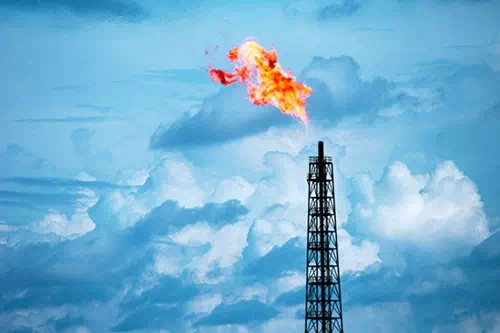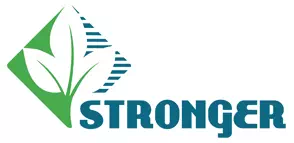|
Well Drilling
Modern oil and natural gas well drilling involves the use of a rotary drill to bore through soil and rock to the desired well depth. The drill bit is constantly washed with a circulating drilling fluid, or 'mud,' which serves to cool and lubricate the bit, counterbalance formation pressure, and remove the cuttings to the surface. If the drill reaches the desired depth and fails to locate a producible deposit of oil or natural gas, the well is plugged and the site is restored to its original condition (as near as possible), and abandoned. Even if oil or natural gas is found, the well may not be producible. For example, the formation may fail to exhibit the right combination of expected volume, porosity, and permeability, making the costs of extraction prohibitive. If an operator determines a well to be producible, the well is completed and prepared for production. There are few federal environmental regulations that apply to the drilling process itself; however, there are a number of possible environmental impacts from the wastes generated during the well drilling that should be kept in mind.
-
Rock fragments (cuttings) are brought to the surface in the drilling fluid. These cuttings pose a problem both in the large volume produced and the muds that coat the cuttings as they are extracted. Drilling mud disposal generally becomes an issue at the end of the drilling process. Rock cuttings from the formations overlying the target formation may contribute contaminants to the drilling mud such as arsenic or metals.
-
Oil-based mud will also contain diesel oil that must be disposed of properly, or more typically, conditioned for reuse. Oil-based muds and cuttings cannot be discharged to surface waters. Both oil-based and synthetic-based fluid are conditioned and reused, which reduces waste volume from drilling operations.
-
Drilling operations also produce air emissions, such as exhaust from diesel engines and turbines that power the drilling equipment. The air pollutants from these devices will be those traditionally associated with combustion sources, including nitrogen oxides, particulates, ozone, and carbon monoxide.
Well drilling also requires the acquisition of a bond to cover the proper plugging and abandonment of wells.
Potentially Applicable Regulations
-
Clean Air Act (CAA)
-
40 CFR Part 60 Subpart A. General provisions, including control device and work practice requirements for flares and compliance with standards and maintenance requirements (maintain air pollution control equipment in a manner consistent with good air pollution control practice for minimizing emissions)
-
40 CFR Part 63 Subpart A. General provisions, General provisions and compliance with standards and maintenance requirements (maintain air pollution control equipment in a manner consistent with good air pollution control practice for minimizing emissions)
-
40 CFR 60 Subpart JJJJ. Standards of Performance for Stationary Spark. Ignition Internal Combustion Engines.
-
40 CFR 60 Subpart IIII. Standards of Performance for Compression Ignition Internal Combustion.
-
40 CFR 63 Subpart ZZZZ. National Emission Standards for Hazardous Air Pollutants for. Stationary Reciprocating Internal Combustion Engines (RICE).
-
40 CFR 68 (CAA 112(r)(1). Chemical accident prevention provisions.
-
40 CFR 98 Subpart W. Petroleum and Natural Gas Greenhouse Gas (GHG) Reporting Rule.
-
Clean Water Act (CWA)
-
Wastewater Point Source Discharges (Section 402). Where direct discharge of wastewater (e.g., flowback, produced water) is permitted, the owner/operator must obtain a National Pollutant Discharge Elimination System (NPDES) permit. NPDES permits are issued by EPA or authorized states.
-
Wastewater Indirectly Discharged via Publicly Owned Treatment Works (POTW) (40 CFR 302). EPA has established pretreatment standards that apply to wastewater (e.g., flowback, produced water) discharged to POTWs by industry.
- General prohibition of discharges of wastewater pollutants from onshore unconventional oil and gas operations to POTWs. (40 CFR 435) The standards prohibit discharges of wastewater pollutants from onshore unconventional oil and gas (UOG) extraction facilities to publicly owned treatment works (POTWs).
-
Wastewater Indirectly Discharged via Centralized Waste Treatment (CWT) (40 CFR 302). When wastewater (e.g., flowback, produced water) is transported to a CWT, it is the responsibility of the CWT to properly treat and discharge it.
-
Stormwater (Section 402, 40 CFR 122). Stormwater is generated when precipitation from rain and snowmelt events flows over land or impervious surfaces and does not percolate into the ground.
-
Waterbody/Wetlands Protection (Sections 401 and 404). Water quality standards and dredge and fill regulations may apply to wetlands and all other jurisdictional waters, including headwater streams.
-
Spill Prevention, Control and Countermeasures (SPCC) (Section 311, 40 CFR 112). Includes requirements for oil spill prevention, preparedness, and response to prevent oil discharges to navigable waters.
-
Emergency Planning and Community Right-to-Know Act (EPCRA) (Sections 302, 303, 311, and 312). EPCRA requires facilities that use or store hazardous chemicals in certain quantities to report those inventories to state and local emergency planning organizations.
-
Resource Conservation and Recovery Act (RCRA) Subtitle C (hazardous waste) and Subtitle D (solid waste). RCRA is the primary law for regulating solid and hazardous wastes.
- Available emergency response authorities EPA can use to address adverse impacts from natural gas drilling, production and processing:
-
Safe Water Drinking Act (SDWA) (Section 1431). Order to address imminent and substantial endangerment caused by entry of pollutant into public water system.
-
Clean Air Act (CAA) (Section 303). Action to address imminent and substantial endangerment of public health or welfare, or the environment from air emissions or pollution.
- Comprehensive Environmental Response, Compensation, and Liability Act of 1980 (CERCLA) (Section 104) Removal action to address release that may present imminent and substantial endangerment, subject to the "petroleum exclusion."
- Comprehensive Environmental Response, Compensation, and Liability Act of 1980 (CERCLA) (Section 106). Order to address imminent & substantial endangerment, subject to the "petroleum exclusion."
- Clean Water Act (CWA) (Section 504). Action to address imminent & substantial endangerment to health, welfare, or livelihood caused by discharge from "pollution source."
-
CWA/OPA 311 action to address imminent and substantial threat to public health or welfare from discharges of oil or hazardous substances to navigable waters.
- Resource Conservation and Recovery Act (RCRA) (Section 7003). Action to address solid waste handling that may present an imminent & substantial endangerment to health or the environment.
More Resources
NaturalGas.org - Extraction. An educational website maintained by the Natural Gas Supply Association that covers a variety of topics related to the natural gas industry. The purpose of this website is to provide visitors with a comprehensive information source for topics related to natural gas, and present an unbiased learning tool for students, teachers, industry, media, and government.
|






